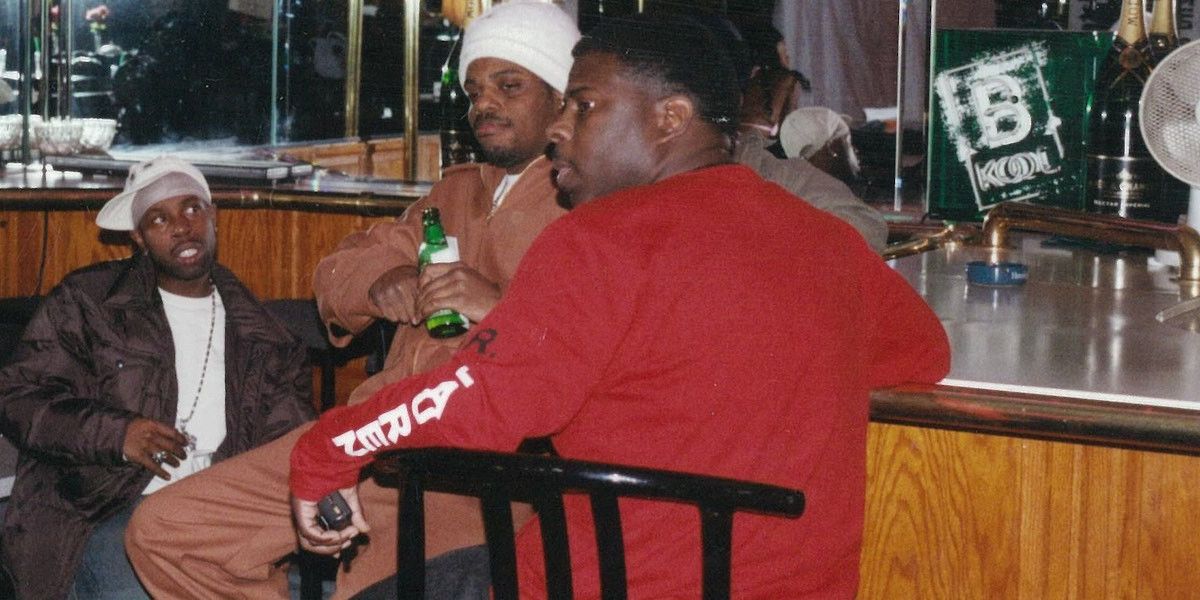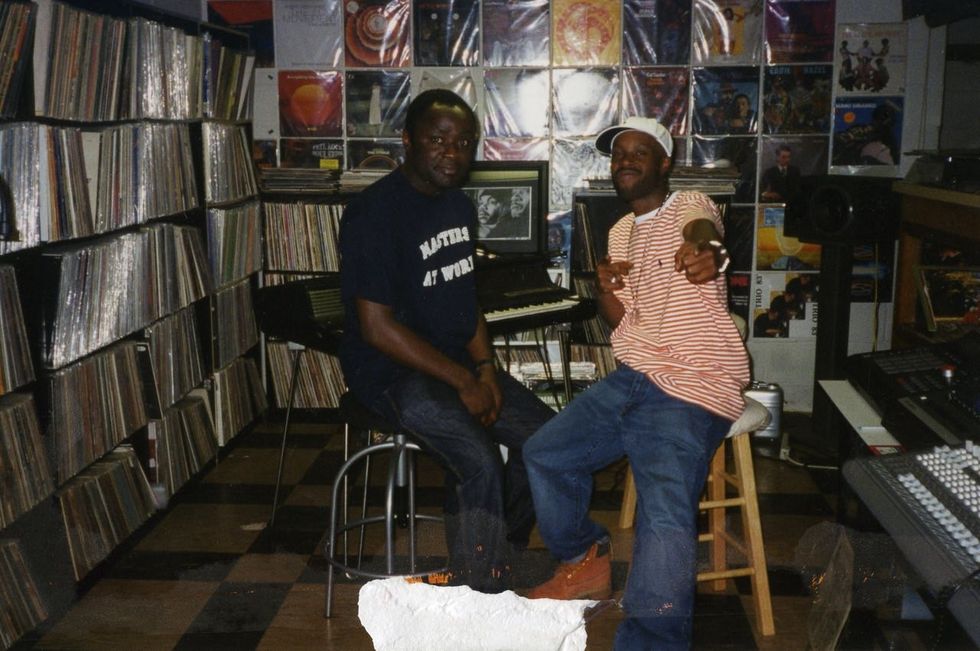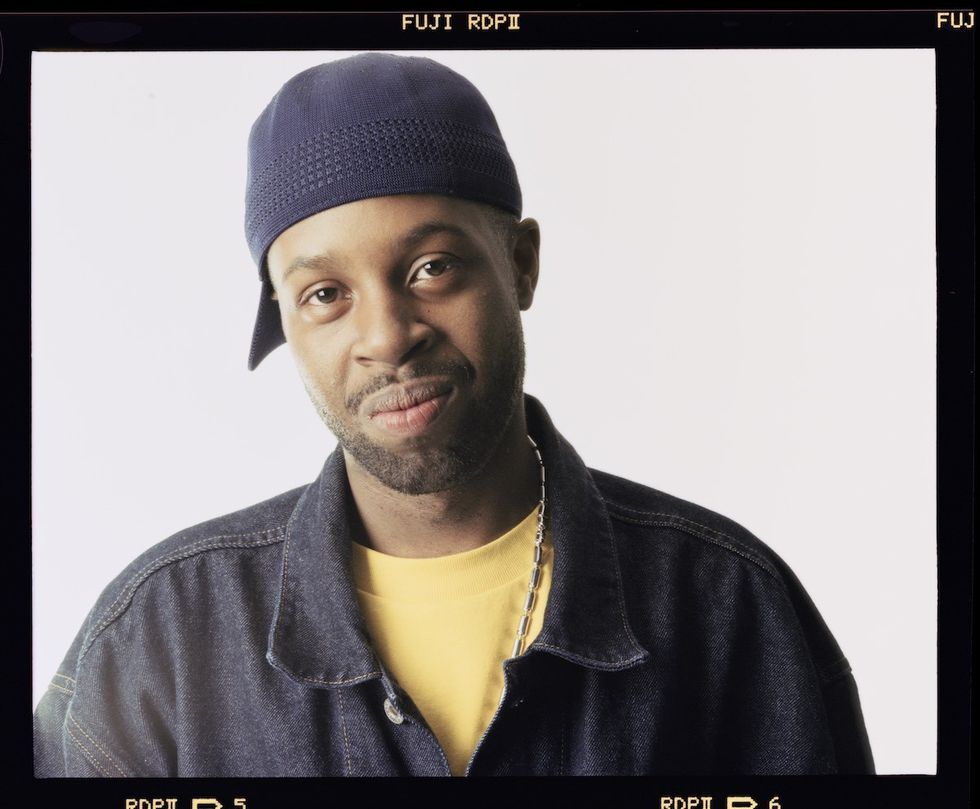
J Dilla
Photo Credit: Peter Adarkwah
To continue reading
Create a free account or sign in to unlock more free articles.
By continuing, you agree to the Terms of Service and acknowledge our Privacy Policy
Register
The content is free, but you must be subscribed to Okayplayer to continue reading.
THANK YOU FOR SUBSCRIBING
Join our newsletter family to stay tapped into the latest in Hip Hop culture!
Login
To continue reading login to your account.
Forgot your password?
Please enter the email address you use for your account so we can send you a link to reset your password:

Next month will be the 20th anniversary of Welcome 2 Detroit, legendary producer J Dilla's masterful debut. To celebrate the occasion, BBE, the label that released the album, will drop a special 20th Anniversary Box Set on February 5th, 2021, just a couple of days before Dilla Day
The box set is massive: it spans 12 discs, featuring instrumentals, unreleased alternative mixes, studio outtakes, and new interpretations by DJs Azymuth and Muro. What's really exciting is that there will also be an oral history breaking down the making of the album. Written by British writer and filmmaker John Vanderpuije, the oral history will include interviews with Dwele, Karriem Riggins, Amp Fiddler, Big Tone, Frank Nitt, Ma Dukes, and more.
Today we are proud to exclusively publish an excerpt from the book, which breaks down the making of the legendary J Dilla jam "Think Twice." We are also proud to share a remix of "Think Twice" from DJ Muro himself. Speaking about the track, Muro told us, via email:
"For us, 'Think Twice' is one of our favorite tracks among the vast catalog of his works so our approach for this remix was not to lose the feel of the groove of the original. It has become an invaluable experience in our lives to produce this remix."
Check out Muro's remix of "Think Twice" above. And read the oral history of the classic track below.
__
Written by John Vanderpuije
Main Players (Alphabetical Order)
Peter Adarkwah (founder of BBE)
Blu (Rapper)
Ma Dukes (J Dilla's mother)
Dwele (Singer, frequent Dilla collaborator)
Elzhi (Rapper, member of Slum Village)
Todd Fairall (J Dilla's recording engineer)
Amp Fiddler (musician and producer)
Frank Nitt (One half of Frank n Dank)
Karriem Riggins (jazz drummer and hip-hop producer)
Ta'Raach (rapper)
Big Tone (rapper, frequent Dilla collaborator)
“Can you do something that’s really multifaceted?”
Ma Dukes said it best, “He’s alive and thriving in every song.”
And not only that, he’s also alive in the memories, anecdotes, and stories shared by his comrades in arms, some 20 years later. And we’re excited to share them, most of all because they demystify his process and humanize J Dilla, giving us a rare glimpse of James Yancey. A shy man. A taskmaster. A deep and uncanny listener. A student with an insatiable appetite for music. Obsessed. Uncompromising. Frustrated. Well raised. Whip-obsessed. Driving through Detroit in various whips of various shapes and sizes. At the mall. At Chocolate City (the strip club) with friends. Smoking. Smiling. Laughing. In the studio. In the studio. In the studio. Single-minded. Dedicated. Generous. Constantly in search of the next groove. Making music as an act of love, and by the sounds of it, infinitely open-hearted.
Ma Dukes: What he did on Welcome 2 Detroit, with the live music, meant so much to him, because he was multifaceted as far as his work in music and sound. He took pride in discovering artists that no one had heard of and seeing what he could do to make sure they could shine in their own unique way. He came up in a household with all types of genres playing all the time. My mom was a country music fan and whenever she’d visit, which was every week, we’d have to spend the hours she came, from daylight to night, playing the music she liked. Dilla’s first influence at a year old was the James Brown sound. Before he could stand up in the playpen, he’d get taken over by the music. That feeling that he had then, I think he always wanted to transfer that into something he created. He wanted us to feel how he felt listening to that James Brown music, I believe.
I loved ["Think Twice"] because that reminded me of when Jay was a young boy and Mr. Yancey didn’t have to work the weekends, and we’d listen to music – and jazz would be what entertained us. Mr. Yancey would teach jazz, and he took a lot of pleasure from it, often doing it for free. So, James was used to it. He knew how to do it, how to sing. He was often a vocalist but he was too busy (laughs). But before they were five, my children knew how to sing jazz classics, acapella in five-part harmonies and stuff like that. That was how parents would torture their children (laughs) and that’s what we did (laughs) with jazz and other music. Everyone would have to learn how to sing Manhattan Transfer songs. That’s how we’d entertain each other. So, I loved “Think Twice” and the EWF — we tore the house up, playing Earth Wind and Fire.
Peter Adarkwah: We were driving around in his car, he had this mixtape on, which he’d made, and “Think Twice” came on the tape and I was like; “Aww man, I know you’re working with Erykah Badu, if you could do a version of this with Erykah singing on it, that would be great!” I always knew he was going to nail the live stuff: I don’t know why but
I wasn’t worried. I was excited as hell. Especially with the hope of getting Erykah on the vocals for “Think Twice,” which unfortunately we didn’t. But I felt he nailed it and I had a feeling he was gonna nail it. I knew he played bass. He had Karriem, who he said was an awesome drummer. He had Dwele. I wasn’t worried.
Dwele: I started off working with Slum Village, at the time I was rhyming and producing, so me and Jay connected that way. I remember going to the Studio A, a couple times. It was me, J Dilla, Waajeed, and Frank. We would always go into the "A room," grab an instrument and just play and see what would come out of it. I’m sure we got some cool samples out of it. I have a couple tapes from those sessions and that’s how we started. Just going into the studio and messing around, seeing what we could come up with, sample wise, from playing random instruments. We would do that for hours, man. Then he called me for Welcome 2 Detroit. When we jammed there were no rules. I don’t even know for sure if Frank really played an instrument or Waajeed. We’d get in there, everybody picks up an instrument, whether you know how to play it or not. We’d hit a note, we’d try to match, see what happens, see if we catch a vibe or sumthin’ like that! If we caught a vibe, and everything made sense, we’d run it for a minute. It was recorded on tape and that would give us something we could sample and possibly turn into a joint, y’know!?! So, we were basically grabbing an instrument and jamming, looking for a moment, whether it made sense or whether it didn’t. When we were in the studio to work on “Think Twice,” Jay had already done a few songs on Welcome 2 Detroit, and he brought me into the studio with intentions on doing a song for that album.
So, I think he already had the songs that he wanted to do and use me for, and it was just a matter of us getting in there and making it happen. That session, I was excited about that, because “Think Twice” was one of my favourite songs. I was interested in how much we were gonna take from the original and how much Detroit we were gonna put on it! (laughs) So I was really eager to see how the project was going to turn out.
Todd Fairall: With “Think Twice,” I think that was one of the first experiences of me working with him as he re-cut or re-imagined something. It was like, “We haven’t done this before — what are we doing here?” This was a record that was made entirely at Studio A. I don’t think anything on that record came from his house. Dwele and his younger brother Antwan Gardner were playing horns on that. We had done some live recording before, but nothing to that level.
Dwele: I remember Wajeed singing the “I really love you” part. Initially, he was singing it with this super gravelly voice and it was so funny and dope. I don’t think that made it to the final album. I brought my little brother to that session and he actually played the trombone on that song, and if I remember correctly, Karriem Riggins was at that session too. I think he was just hanging out, but he was there for that.
Todd Fairall: There’s a moment on “Think Twice” when it strips all the way down to a piano. It got stripped down from this huge production in the mix, with all these instruments, a lot of music, during this breakdown section, to just the piano. I remember we had recorded a bunch of different ideas for “Think Twice” and it was supposed to be a bigger section but as we mixed it, it got stripped down to the piano, finger snaps, and a ride cymbal – that’s him playing that live. Also, during the opening of the song J Dilla is playing the piano with a guitar pick. He reached into the piano and with his hand inside, he starts picking the strings instead of using the keys and it sounds exactly like what I described. This wasn’t even a thing (laughs) because he was always experimenting, it was just like – all of a sudden, he’s out there and he’s like, “Will you record this?”
Dwele: Yeah, I remember that, (laughs) I remember Jay plucking the piano strings with a guitar pick!
Todd Fairall: At the time of Welcome 2 Detroit, J Dilla was using the foundation of the MPC but he got a little bit more experimental. There was more keyboard being used, more acoustic instruments being used. Him playing piano on that record, playing the acoustic drums. I wanna even say, he picked up a guitar and came up with a guitar riff for a record around this time as well.
Big Tone: A lot of what we listen to here in Detroit, is techno and there’s a lot of the jazz influences going along with that, or a lot of jazz influences that go along with hip-hop or with the neo-soul thing and all of that. It felt like “Think Twice” embodied all of that. It’s a very Detroit sound. But it’s a classic take on a record that I wouldn’t necessarily expect anyone to touch, especially not for a “hip hop” record either. It was dope, all the transitions, all the different elements that build up through the progression of the record. Dwele with the horns and everything, that was a really dope piece. It’s like he could actually flip a whole live music project like that if he wanted to. I felt like he was showing out. Kinda showing that there were no boundaries. There was no box that you could put him in. He could do anything.

Peter Adarkwah: For me, the whole thing about this album was going to Dilla and saying; “I know you’re into different stuff, I want you to do an album that shows your influences and not just by way of sampling different stuff.” I know he played bass on Mama’s Gun, and it was like: “Can you do something that’s really multifaceted?”
Karriem Riggins: I think this was Dilla showing his versatility. He could sing, he could play drums, he could play the keys, bass and a lot of producers just push buttons on a machine. Jay could actually play instruments. He set the bar high for other producers. Dilla will make something out of whatever’s there. Even if it was like, say… a bluegrass CD. He’d go through it, like; “I’m gonna find something and make something dope out of it.” He could make something out of anything recorded and make it hip. It was a challenge for him and that’s how a lot of that stuff came about. He’d start from a motif, or a sound, or an idea and it just blossoms from there.
Ta'Raach: I was shocked that he decided to cover “Think Twice” and where it came in on the record. It was almost like he pulled the song into his domain, capturing the groove and rolling with it. But to put the live instrumentation on there, and then have singing, I think he was showing that it doesn’t have to be rugged raps and boom baps. You can actually flip it around and give it a groove, give it some sophistication. He went from “Y’all Ain’t Ready” to something that’s so sophisticated in terms of production.
Blu: Detroit is so fast-paced, so hearing those songs with the live instrumentation like “Think Twice,” they slow things down with a nice, mellow vibe. It feels like hip-hop and jazz at the same time! It’s smooth but it’s got that beat to it.
Elzhi: Me and Dwele we were in a group together at one point. Dwele was also on an EP that me and House Shoes put out called Out of Focus. So, this track and the whole album felt like family. I was amazed at what I was hearing and how well “Think Twice” was executed. Because to go from something so raw with “Y’all Ain’t Ready” to something so smooth, that transition? That’s not easy to do, it’s not easy to make it sound cohesive. Dilla was a master at that.

Frank Nitt: Him selecting “Think Twice,” to redo was not surprising, musically. I think getting up there and singing a lil’ bit, was more surprising. It wasn’t like the Slum [Village] thing, where they’re chanting on the chorus or whatever. It was like him getting up there to hit notes! Dilla had sang as a kid in church, so it wasn’t a thing, but he had never done it like that and in that context. So that was more surprising that he’d do R&B singing. 'Cause from a rapper standpoint, the sing-song thing – not now, now is different – but especially back then, it was more like chants as opposed to actual singing. Then with “Think Twice” he in their hitting ad-libs like (sings) he had to be real light and airy (laughs). So I think that was more the surprise. But for me, it was normal though, because I had seen Slum create and they were very melody orientated with their music. So, seeing them have that kind of melodic vibe was normal. But seeing him go R&B, on a jazz song so to speak – he did it the way he did it, but it wasn’t hip-hop. It wasn’t a hip-hop version of it and I guess that was him flexing his musical muscles. He did whatever felt good and that was a big thing with him.
Big Tone: I had never heard Jay try to do a singing approach to anything, really. So, to hear him make that move was like, “Maybe I don’t know where this record is going?” (laughs)
Like when we first heard it, it was like, "OK, he has some things on this record that kinda stand out differently than what I thought he was gonna be doing." Once again, super dope! It’s another record that steps outside of samples and splices, showing an example of the musicianship that he had.
Amp Fiddler: I love “Think Twice” and “Rico Suave Bossa Nova.” I had a Fender Rhodes in the basement, all those funky ass instruments, synthesizers and shit. So, he had some exposure to all of that. At the same time, he watched me and my brother, Bubz, play together. So, we recorded and sampled like he did. From time to time Dilla would have me play. Somebody like a Dilla, even without my influence, would like the live aspect of music. Because he grew up in that environment, with his parents and his school and his teachers. It wasn’t just me, it’s because that’s how he was raised.
__
John Vanderpuije, aka JV, is a filmmaker, writer, and artist based in London. He has art directed projects for Nike and Dizzee Rascal and created album cover art for MF DOOM and British rapper Ty. He has written for Dazed & Confused, Straight No Chaser, Vice, and The Fader and written TV scripts for the BBC. His short film, Trim, has screened around the world and he is working on new movies/projects through his production company, Land of Lasarica.